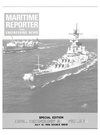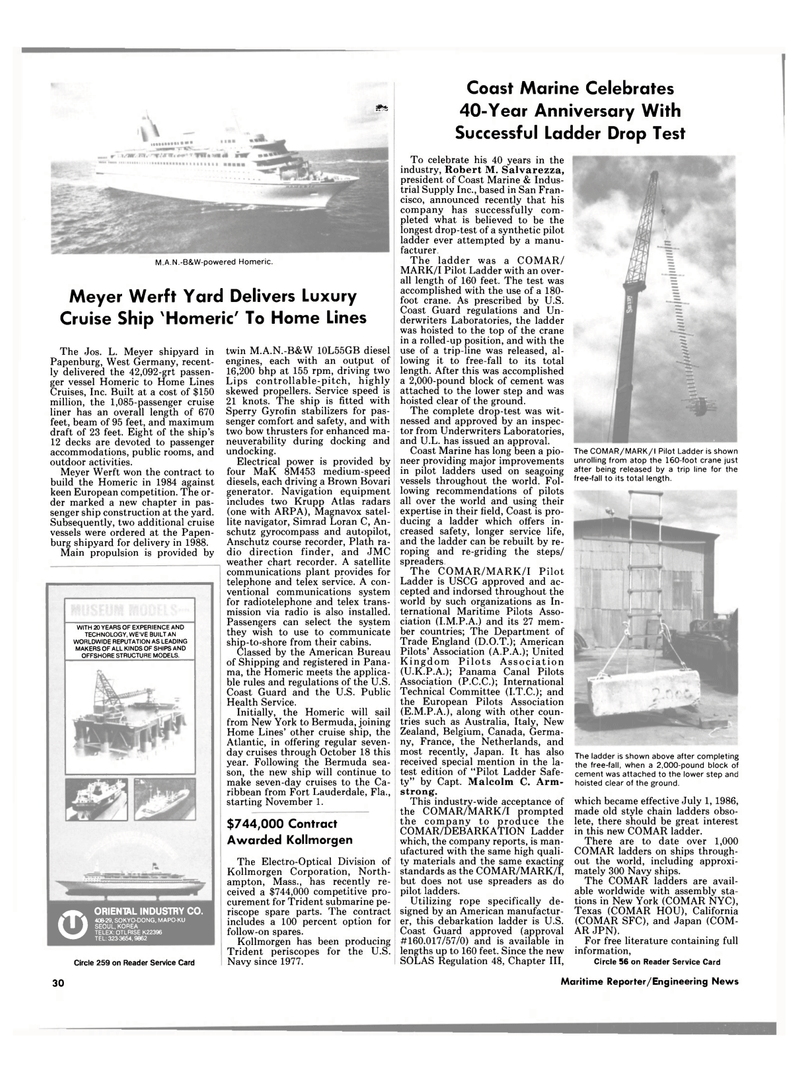
Page 30: of Maritime Reporter Magazine (July 15, 1986)
Read this page in Pdf, Flash or Html5 edition of July 15, 1986 Maritime Reporter Magazine
jfak
M.A.N.-B&W-powered Homeric.
Meyer Werft Yard Delivers Luxury
Cruise Ship 'Homeric' To Home Lines
The Jos. L. Meyer shipyard in
Papenburg, West Germany, recent- ly delivered the 42,092-grt passen- ger vessel Homeric to Home Lines
Cruises, Inc. Built at a cost of $150 million, the 1,085-passenger cruise liner has an overall length of 670 feet, beam of 95 feet, and maximum draft of 23 feet. Eight of the ship's 12 decks are devoted to passenger accommodations, public rooms, and outdoor activities.
Meyer Werft won the contract to build the Homeric in 1984 against keen European competition. The or- der marked a new chapter in pas- senger ship construction at the yard.
Subsequently, two additional cruise vessels were ordered at the Papen- burg shipyard for delivery in 1988.
Main propulsion is provided by
WITH 20 YEARS OF EXPERIENCE AND
TECHNOLOGY, WE'VE BUILT AN
WORLDWIDE REPUTATION AS LEADING
MAKERS OF ALL KINDS OF SHIPS AND
OFFSHORE STRUCTURE MODELS. 0 ORIENTAL INDUSTRY CO. 408-29, SOKYO-DONG, MAPO-KU SEOUL, KOREA
TELEX: OTLRISE K22396
TEL: 323-3654,9862
Circle 259 on Reader Service Card twin M.A.N.-B&W 10L55GB diesel engines, each with an output of 16,200 bhp at 155 rpm, driving two
Lips controllable-pitch, highly skewed propellers. Service speed is 21 knots. The ship is fitted with
Sperry Gyrofin stabilizers for pas- senger comfort and safety, and with two bow thrusters for enhanced ma- neuverability during docking and undocking.
Electrical power is provided by four MaK 8M453 medium-speed diesels, each driving a Brown Bovari generator. Navigation equipment includes two Krupp Atlas radars (one with ARPA), Magnavox satel- lite navigator, Simrad Loran C, An- schutz gyrocompass and autopilot,
Anschutz course recorder, Plath ra- dio direction finder, and JMC weather chart recorder. A satellite communications plant provides for telephone and telex service. A con- ventional communications system for radiotelephone and telex trans- mission via radio is also installed.
Passengers can select the system they wish to use to communicate ship-to-shore from their cabins.
Classed by the American Bureau of Shipping and registered in Pana- ma, the Homeric meets the applica- ble rules and regulations of the U.S.
Coast Guard and the U.S. Public
Health Service.
Initially, the Homeric will sail from New York to Bermuda, joining
Home Lines' other cruise ship, the
Atlantic, in offering regular seven- day cruises through October 18 this year. Following the Bermuda sea- son, the new ship will continue to make seven-day cruises to the Ca- ribbean from Fort Lauderdale, Fla., starting November 1. $744,000 Contract
Awarded Kollmorgen
The Electro-Optical Division of
Kollmorgen Corporation, North- ampton, Mass., has recently re- ceived a $744,000 competitive pro- curement for Trident submarine pe- riscope spare parts. The contract includes a 100 percent option for follow-on spares.
Kollmorgen has been producing
Trident periscopes for the U.S.
Navy since 1977.
Coast Marine Celebrates 40-Year Anniversary With
Successful Ladder Drop Test
To celebrate his 40 years in the industry, Robert M. Salvarezza, president of Coast Marine & Indus- trial Supply Inc., based in San Fran- cisco, announced recently that his company has successfully com- pleted what is believed to be the longest drop-test of a synthetic pilot ladder ever attempted by a manu- fscturcr
The ladder was a COMAR/
MARK/I Pilot Ladder with an over- all length of 160 feet. The test was accomplished with the use of a 180- foot crane. As prescribed by U.S.
Coast Guard regulations and Un- derwriters Laboratories, the ladder was hoisted to the top of the crane in a rolled-up position, and with the use of a trip-line was released, al- lowing it to free-fall to its total length. After this was accomplished a 2,000-pound block of cement was attached to the lower step and was hoisted clear of the ground.
The complete drop-test was wit- nessed and approved by an inspec- tor from Underwriters Laboratories, and U.L. has issued an approval.
Coast Marine has long been a pio- neer providing major improvements in pilot ladders used on seagoing vessels throughout the world. Fol- lowing recommendations of pilots all over the world and using their expertise in their field, Coast is pro- ducing a ladder which offers in- creased safety, longer service life, and the ladder can be rebuilt by re- roping and re-griding the steps/ sprGHdcrs
The COMAR/MARK/I Pilot
Ladder is USCG approved and ac- cepted and indorsed throughout the world by such organizations as In- ternational Maritime Pilots Asso- ciation (I.M.P.A.) and its 27 mem- ber countries; The Department of
Trade England (D.O.T.); American
Pilots' Association (A.P.A.); United
Kingdom Pilots Association (U.K.P.A.); Panama Canal Pilots
Association (P.C.C.); International
Technical Committee (I.T.C.); and the European Pilots Association (E.M.P.A.), along with other coun- tries such as Australia, Italy, New
Zealand, Belgium, Canada, Germa- ny, France, the Netherlands, and most recently, Japan. It has also received special mention in the la- test edition of "Pilot Ladder Safe- ty" by Capt. Malcolm C. Arm- strong.
This industry-wide acceptance of the COMAR/MARK/I prompted the company to produce the
COMAR/DEBARKATION Ladder which, the company reports, is man- ufactured with the same high quali- ty materials and the same exacting standards as the COMAR/MARK/I, but does not use spreaders as do pilot ladders.
Utilizing rope specifically de- signed by an American manufactur- er, this debarkation ladder is U.S.
Coast Guard approved (approval #160.017/57/0) and is available in lengths up to 160 feet. Since the new
SOLAS Regulation 48, Chapter III,
The COMAR/MARK/I Pilot Ladder is shown unrolling from atop the 160-foot crane just after being released by a trip line for the free-fall to its total length.
The ladder is shown above after completing the free-fall, when a 2,000-pound block of cement was attached to the lower step and hoisted clear of the ground. which became effective July 1, 1986, made old style chain ladders obso- lete, there should be great interest in this new COMAR ladder.
There are to date over 1,000
COMAR ladders on ships through- out the world, including approxi- mately 300 Navy ships.
The COMAR ladders are avail- able worldwide with assembly sta- tions in New York (COMAR NYC),
Texas (COMAR HOU), California (COMAR SFC), and Japan (COM-
AR JPN).
For free literature containing full information,
Circle 56 on Reader Service Card 30 Maritime Reporter/Engineering News

 29
29

 31
31
